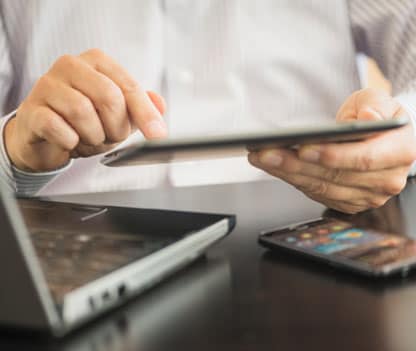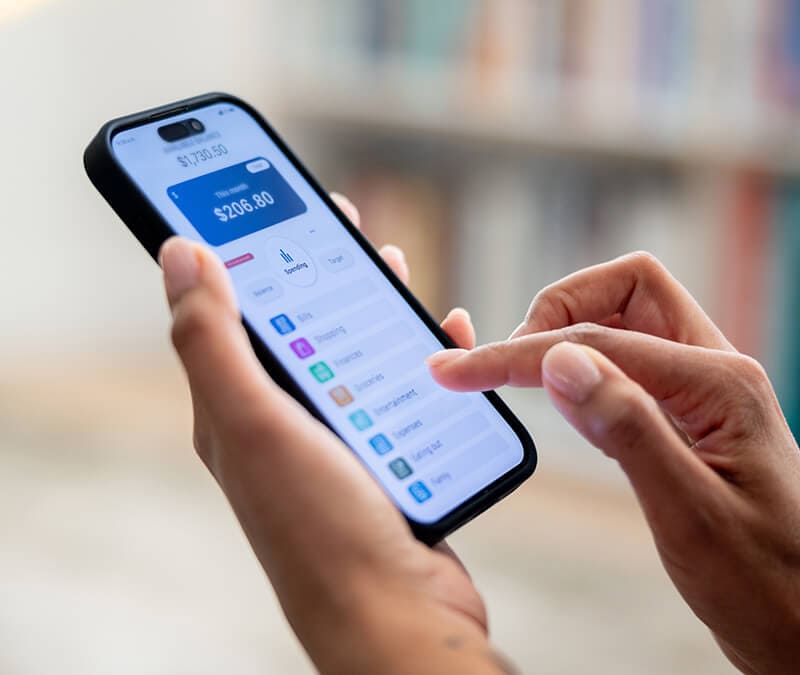Cyber safety guide: Tips to Own IT. Secure IT. Protect IT.
If you’re looking for a strategy to help you stay safe and secure online, try this: Own IT. Secure IT. Protect IT.

If you’re looking for a strategy to help you stay safe and secure online, try this: Own IT. Secure IT. Protect IT.
What does it mean? It means what you do online has an impact on your online privacy and device security. That might range from the security software you run on your devices to the personal information you post on social media.
You don’t have to “Own IT. Secure IT. and Protect IT.” alone. October is National Cyber Safety Awareness Month and those six words happen to be the 2019 theme. NCSAM (pronounced N-C-Sam) is a time for you — and everybody else — to rally around cybersecurity. So you might find a buddy.
Here are some tips and resources that can help.
Own IT.
“Owning it” means taking responsibility for your personal information and online privacy. How? Here are three ways you can get started.
Stay safe on social media
Social media offers the opportunity to share your life with the world, but keep a few things in mind. Cybercriminals might cherry pick your information to commit identity theft and financial fraud. Here are a few safeguards to keep in mind.
Limit what you share. You probably know it’s not a good idea to share your address, phone number, or financial information on social platforms, but what about the name of your pet? If your pet’s name happens to be the answer to one of your security questions, it’s best to keep Rover anonymous.
Mix your passwords. It’s smart to use a unique, complex password for each of your social media accounts. If cybercriminals manage to access one of your passwords, they won’t be able to compile personal information mined from your other social media platforms.
Check your privacy and security settings. You can adjust your settings to help control who sees what you post. Stick with people you trust. Also, consider turning off location services. Not every app needs to be able to track where you are.
Learn more
Update your privacy settings
You probably have more privacy settings than you might realize. Just about every online service and device you use has one. Here are some of the categories where privacy settings are important.
E-commerce. Think Amazon, eBay, and a host of other retail websites where you might do business. For instance, you may be able to stop a website from tracking your browsing activity.
Email. The services that provide you email and video calls may know a lot about your usage. But you can adjust your privacy settings to limit the apps and websites that are authorized to access your email or browser accounts.
Mobile and location services. Whether you use Android or iOS, AT&T or T-Mobile or a pay as you go service, your privacy settings can help control how much of your data you share.
Music. Your music service probably knows more about you than just your favorite song. Services like Spotify and Pandora all come with privacy settings that can help you restrict access to your data. For instance, you may be able to cut off your music activity from the public, at least temporarily.
Photo and video sharing. The same goes for apps like Instagram and Snapchat. For instance, you can set your account to private so that only approved followers can see what you share. Keep in mind it’s always a good idea to revisit your privacy setting when privacy agreements change.
Rideshare services. Whether you Uber or Lyft, you might be sharing more data than you want to. For instance, you may be able to adjust your privacy settings to prevent a ride service from tracking your location when you’re not using the app.
Search engines. You may leave a lot of digital tracks when you explore the web. Search engines like Google, Yahoo, and DuckDuckGo offer you some control over what gets tracked and shared.
Social networks. Facebook, LinkedIn, and other social media platforms likely know a lot about your personal and professional lives. Another good reminder to read privacy policies — though they may contain thousands of words — and adjust your privacy settings to share less.
It’s not always easy to find where to go to update your privacy settings. The National Cyber Security Alliance — the same organization that brings you NCSAM — provides direct links to the privacy pages for many of your devices and services. Check it out here.
Learn more
Keep tabs on your apps
Here’s a statistic: The average smartphone user has between 60 to 90 apps on their device.
That’s a lot of apps. And most request some of your personal information when you download them — like, your name, your email address, or even your home address. Some apps also request access to your camera and microphone.
Before you download an app, read the app developer’s privacy statement to find out how your personal information might be used or shared.
Here are three mobile-privacy questions to consider before you download an app.
- Do I know what personal information the app is requesting?
- Am I OK with sharing my personal information with the app developer?
- Does the app really need the device permission it’s requesting to provide its service or content?
And consider this: If your app integrates with social media — this happens when you sign in to an app using your social media account — your app and your social media account may be sharing your data with each other.
Learn more
Secure IT.
“Securing it” means taking steps to help keep your devices and your personal information safe. Here are five ways to help make that happen
Shake up your password protocol
Create strong unique passwords. A strong password contains a combination of at least 12 letters, numbers, and special characters. If you need help keeping track of your passwords, you might consider a password manager.
Learn more
Double your log-in
Turn on multifactor authentication. This adds a layer of protection when signing into your account. For instance, you might type in your login credentials, then type in a one-time identification code you receive on your mobile device. The idea? Even if cybercriminals manage to access your log-in credentials, they likely won’t be able to find out your I.D. code.
Update privacy settings
Consider updating your privacy settings to high. It’s a good idea to limit as much access as you can to your web activity and personal information. Here’s a link to update your privacy settings on popular devices and online services.
Shop safe online
No one wants to land on a bogus retail website and divulge credit card information to cybercriminals. Here a sample of things you can do to help stay safe when shopping online.
Shop at websites you trust. If you land on a website you’ve never heard of and it offers unbelievably low prices, you might want to play it safe and stick with a trusted site. Cybercriminals set up some websites just to snatch your payment information.
Avoid public Wi-Fi. Someone can intercept the data you send and receive — including your credit card information — when shopping on free public Wi-Fi. That information might be used to commit identity theft.
Learn more
Use a VPN. A virtual private network can help if you want to use a public Wi-Fi connection to shop. It makes your data safer while in transit.
Learn more
Check website security. Only shop on websites with URLs that begin with “https.” If the “s” is missing after “http,” it means the webpage isn’t secure.
Learn how to spot and avoid phishing emails
A phishing email is designed to trick you into clicking on a link. The email might look — more or less — like it’s from a trusted source.
If you click on the link, you could land on an illegitimate web page that resembles your bank’s website and unknowingly provide personal information to a cybercriminal. Or that click might download malware onto your device.
Either way, you’ll want to avoid being scammed by phishing attacks. Here’s how.
Don’t open suspicious emails. You might receive an email with an alarming subject line like “Account suspended!” Delete it. It’s not from your financial provider. Log in to your account directly, if you think there might be a problem.
Don’t click on links in suspicious emails. If you open an email from someone you don’t know and you’re instructed to click on a link, don’t do it. The link might take you to a fraudulent website that could either install malware on your computer or that tricks you into providing sensitive personal information.
Don’t send financial information through email. Legitimate financial companies like your bank or credit card issuer won’t ask you to send passwords, account numbers, or your Social Security number through email. But scammers will.
Learn more
Protect IT.
“Protecting it” means having tech safeguards in place when you go online. A rule of thumb? If you connect, you must protect.
Mind your updates. Keeping your security software updated to the latest version, web browser, and operating systems can help keep cybercriminals out. In part, the updates are designed to patch security holes that cybercriminals might use to access your personal information or infect your devices with malicious software. Bottom line? Don’t ignore your updates.
Learn more
- 5 reasons general software updates and patches are important
- How to clean your computer: Software and hardware
Stay protected while connected. Exploring the web or buying something while on an unsecured Wi-Fi network means your private information or browsing habits might be exposed. A virtual private network — VPN for short — can help if you’re concerned about online security and privacy.
A VPN encrypts the data you send and receive and provides online anonymity. That means you can send emails, shop online, or pay bills, with greater privacy. Plus, VPNs also help keep your web browsing anonymous.
Learn more
Keep owning it, securing it, and protecting it
Now you have some of the basic tools and resources to help protect against cybercrime.
A final note: Own IT. Secure IT. Protect IT. works as a theme for National Cyber Safety Awareness Month. But as your personal cybersafety strategy, you’ll need to employ it every day of the year.
Editorial note: Our articles provide educational information for you. Our offerings may not cover or protect against every type of crime, fraud, or threat we write about. Our goal is to increase awareness about Cyber Safety. Please review complete Terms during enrollment or setup. Remember that no one can prevent all identity theft or cybercrime, and that LifeLock does not monitor all transactions at all businesses. The Norton and LifeLock brands are part of Gen Digital Inc.





Want more?
Follow us for all the latest news, tips, and updates.